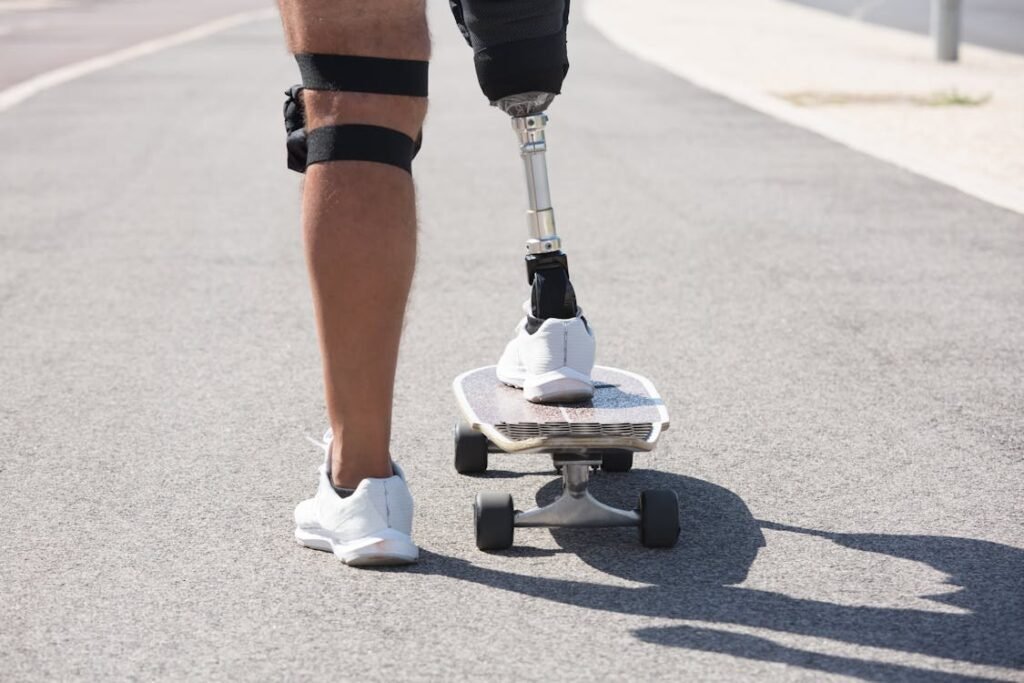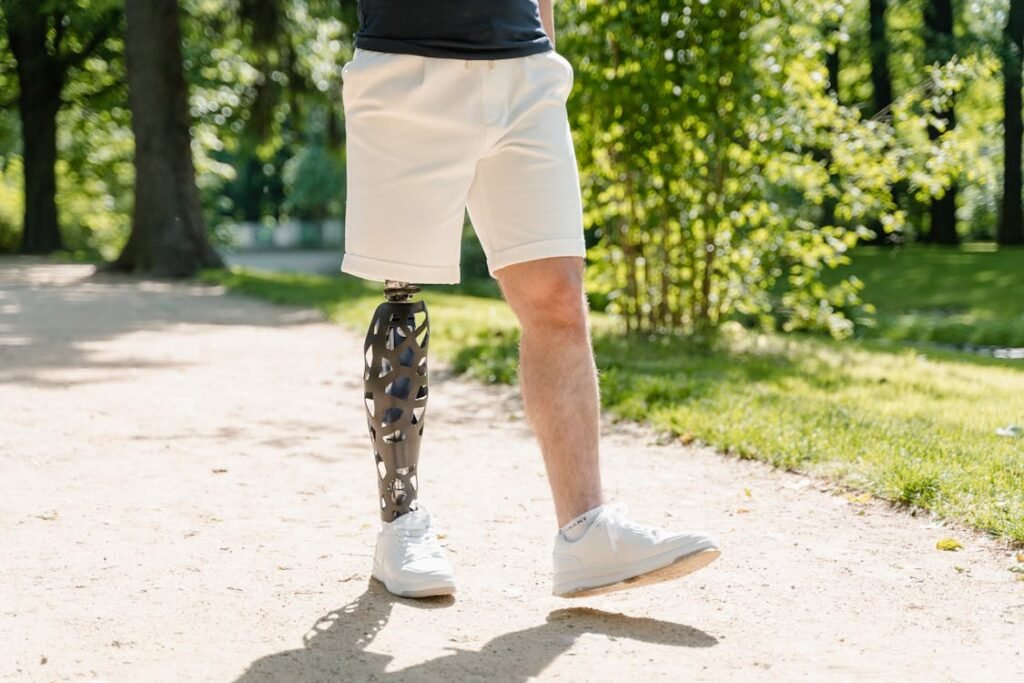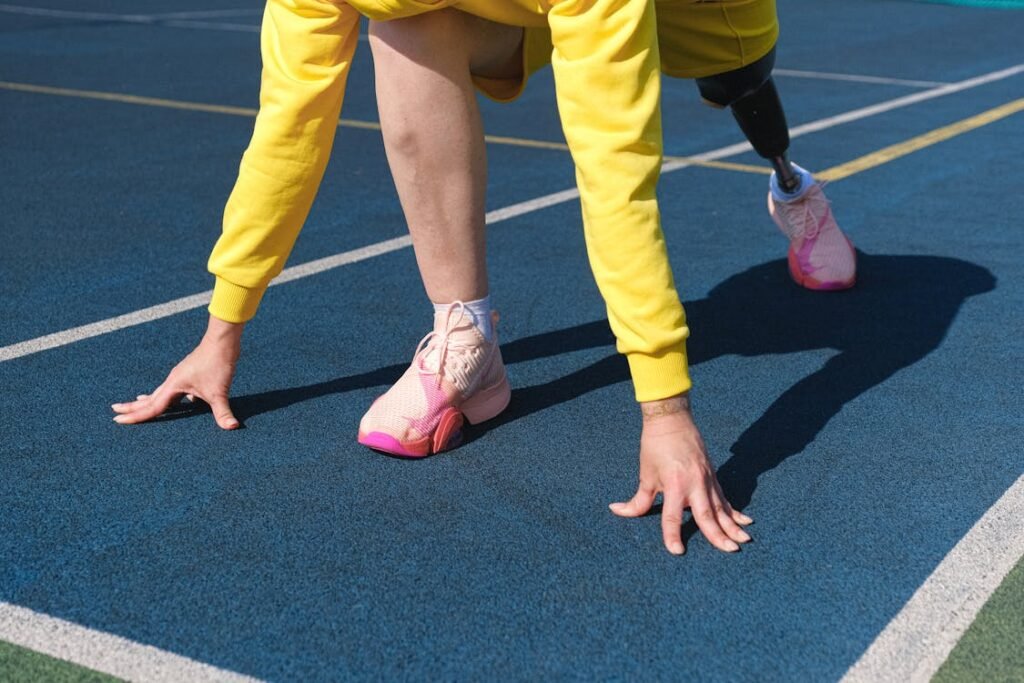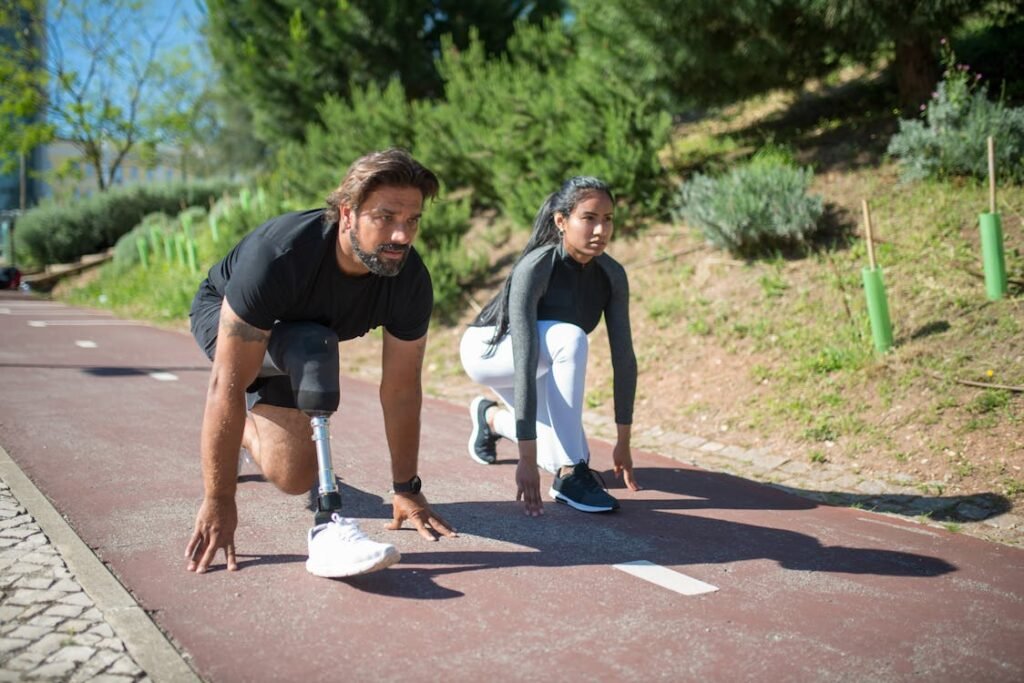Losing part of a foot changes the way a person stands, walks, and balances. The foot plays a critical role in absorbing shock, pushing off the ground, and maintaining stability. When part of it is missing, weight shifts unevenly, balance is harder to control, and movement can feel unsteady.
Prosthetic footwear helps restore stability by replacing lost foot function. It provides support, improves weight distribution, and helps prevent issues like pressure sores and joint pain. For partial foot amputees, the right footwear can mean the difference between discomfort and confident movement.

Understanding Stability Challenges for Partial Foot Amputees
When part of the foot is missing, walking mechanics change significantly. The foot is designed to distribute weight evenly, absorb impact, and provide a stable base for movement.
Partial foot amputees lose some of this natural function, which can lead to instability, fatigue, and discomfort.
How Foot Structure Affects Balance
The foot has three main points of contact with the ground: the heel, the ball of the foot, and the toes. These work together to create balance and a smooth walking motion.
When any part is missing, the remaining foot must compensate, often leading to unnatural weight shifts and increased strain on other parts of the body.
For example, if the toes or front of the foot are missing, pushing off the ground becomes difficult. This can make each step feel less powerful, requiring extra effort from the leg and hip.
If the heel is affected, landing becomes less stable, making balance harder to maintain. Over time, this imbalance can lead to pain in the knees, hips, or lower back.
The Risk of Uneven Weight Distribution
Without proper support, partial foot amputees may place excessive pressure on the remaining foot.
This can cause skin irritation, blisters, and even ulcers, particularly for individuals with diabetes or circulation issues. Overcompensating with the other leg can also lead to long-term joint problems.
Prosthetic footwear helps redistribute weight more evenly, reducing stress on sensitive areas. By restoring some of the lost foot function, it helps amputees walk with greater confidence and less discomfort.
How Instability Affects Everyday Movement
Walking on uneven ground, standing for long periods, or climbing stairs can be particularly challenging for partial foot amputees. Without proper support, small movements can feel unsteady, increasing the risk of falls.
Over time, instability can also affect posture. Many amputees unconsciously change how they walk to avoid discomfort, which can lead to poor alignment and additional strain on the body.
Prosthetic footwear helps maintain a more natural walking pattern, reducing the risk of secondary complications.

How Prosthetic Footwear Restores Stability
Prosthetic footwear is specifically designed to support partial foot amputees by improving weight distribution, enhancing balance, and restoring lost foot function.
Unlike standard shoes, these specialized solutions help create a more stable walking experience and prevent long-term complications.
Rebalancing Weight Distribution
One of the most important functions of prosthetic footwear is redistributing weight evenly across the foot.
When part of the foot is missing, the remaining section often bears more load than it was designed for, leading to discomfort and instability.
A well-fitted prosthetic shoe or insole compensates for the missing portion of the foot by spreading pressure evenly. This reduces strain on the remaining foot structures, preventing pressure sores and improving comfort.
By mimicking the foot’s natural shape, prosthetic footwear allows for a more balanced walking motion, reducing the risk of muscle fatigue and joint pain.
Enhancing Push-Off and Forward Motion
Walking requires a smooth transition from heel to toe. The front part of the foot, especially the toes, plays a crucial role in propelling the body forward.
When this function is lost due to amputation, walking can feel sluggish and uneven.
Prosthetic footwear restores push-off power by incorporating toe fillers, carbon fiber plates, or custom-designed soles that simulate natural foot movement.
These features help create a spring-like effect, making each step feel more natural and efficient. By reducing the extra effort needed to walk, prosthetic footwear helps conserve energy and prevent fatigue.
Improving Stability on Uneven Surfaces
Walking on sloped or uneven surfaces can be particularly challenging for partial foot amputees. The lack of a complete foot structure makes it harder to adapt to changes in terrain, increasing the risk of tripping or losing balance.
Prosthetic footwear enhances stability by providing a larger and more supportive contact surface with the ground.
Reinforced soles and structured designs help amputees maintain better control over their footing, making walking on grass, gravel, or stairs much safer and more manageable.
Reducing Overcompensation and Long-Term Strain
Without proper support, partial foot amputees often adjust their walking patterns to compensate for instability.
This can lead to an unnatural gait, which places excessive stress on the hips, knees, and lower back. Over time, this can cause joint pain and posture problems.
Prosthetic footwear helps align the body correctly by restoring a more natural walking motion. By allowing the foot to function as a stable base, it prevents excessive strain on other parts of the body.
This not only improves comfort but also reduces the likelihood of developing long-term musculoskeletal issues.

Types of Prosthetic Footwear and Their Impact on Stability
Different types of prosthetic footwear are available to address the unique needs of partial foot amputees. The right choice depends on the level of amputation, lifestyle, and personal comfort preferences.
Each type of prosthetic footwear is designed to enhance stability, reduce strain, and improve mobility.
Custom Insoles for Partial Foot Support
For individuals who have lost only a small portion of their foot, such as toes or the front part, custom insoles provide additional support and balance.
These insoles fill the missing space inside the shoe, helping to distribute weight evenly and preventing excessive pressure on the remaining foot.
Insoles also improve foot alignment, reducing the risk of overpronation or supination, which can cause instability.
By ensuring that the foot sits evenly inside the shoe, custom insoles help amputees maintain better posture and balance while walking.
Toe Fillers and Forefoot Prosthetics
For amputations that affect the toes or front part of the foot, toe fillers and forefoot prosthetics play a crucial role in restoring stability.
These lightweight prosthetic additions are designed to replicate the lost portion of the foot, allowing for a smoother transition from heel to toe during walking.
Without the front part of the foot, pushing off the ground becomes difficult. Forefoot prosthetics help restore this function by creating a stable base for forward movement.
Many designs incorporate flexible or semi-rigid materials that allow for a more natural stride, reducing the extra effort required to walk.
Carbon Fiber Footplates for Energy Return
For active amputees, carbon fiber footplates are a popular choice. These thin, strong plates are inserted into the shoe to provide additional support and energy return during movement.
Carbon fiber footplates help stabilize the foot by reinforcing the shoe’s sole, preventing excessive bending or collapsing.
They also improve propulsion by mimicking the natural push-off function of the toes, making walking feel more efficient and reducing fatigue.
Ankle-Foot Orthoses (AFOs) for Maximum Support
For amputations that extend further into the midfoot, ankle-foot orthoses (AFOs) provide the highest level of stability and support.
These devices wrap around the ankle and lower leg, ensuring that weight is distributed evenly while preventing excessive movement of the foot inside the shoe.
AFOs help correct gait abnormalities and provide additional balance support, especially for individuals who struggle with weak or unstable ankle movement.
By securing the foot in the correct position, these devices make walking more predictable and less tiring.
Custom Prosthetic Shoes for Everyday Use
Some partial foot amputees require specialized prosthetic shoes that integrate all of these support elements into a single design.
These shoes are custom-made to fit the unique shape of the residual foot while incorporating reinforced soles, toe fillers, and built-in stability features.
Unlike standard shoes, prosthetic shoes provide a secure fit that prevents excessive shifting or rubbing, reducing the risk of skin irritation and discomfort.
Many modern designs also prioritize aesthetics, allowing users to wear stylish and functional footwear without sacrificing support.

The Role of Proper Fit in Prosthetic Footwear Stability
No matter how advanced prosthetic footwear is, its effectiveness depends on how well it fits. A poor fit can lead to discomfort, instability, and even long-term health issues.
Ensuring the right fit is one of the most important aspects of using prosthetic footwear successfully.
Preventing Excessive Movement Within the Shoe
For partial foot amputees, a loose-fitting shoe can cause instability and discomfort. If the foot moves too much inside the shoe, it can lead to friction, blisters, and an increased risk of falling.
On the other hand, a shoe that is too tight can create pressure points, restricting blood flow and causing pain.
Prosthetic footwear is designed to create a snug but comfortable fit that holds the foot securely in place. Custom insoles, toe fillers, and properly contoured footbeds help eliminate gaps within the shoe, ensuring a stable base for movement.
Maintaining Even Weight Distribution
A well-fitted prosthetic shoe ensures that weight is distributed evenly across the entire foot. Without proper weight distribution, some areas bear more pressure than others, leading to discomfort and potential injury.
This is especially important for individuals with diabetes or circulation problems, who are at higher risk for foot ulcers and skin breakdown.
Prosthetists work closely with patients to make sure their footwear provides balanced support. In some cases, minor adjustments—such as adding additional padding or modifying the shoe’s shape—can significantly improve weight distribution and walking efficiency.
Enhancing Comfort for Long-Term Use
Since prosthetic footwear is worn daily, comfort is just as important as stability. Materials like medical-grade foam, gel inserts, and breathable fabrics help reduce irritation and improve overall comfort.
Some designs also incorporate shock-absorbing features to reduce impact when walking on hard surfaces.
Comfortable footwear allows partial foot amputees to stay active and mobile without experiencing fatigue or discomfort. A well-cushioned, properly contoured fit helps prevent pain, making it easier to engage in everyday activities with confidence.
The Importance of Regular Adjustments
Over time, a person’s residual foot shape and walking habits may change. This means that prosthetic footwear may need to be adjusted periodically to maintain an optimal fit.
Prosthetists recommend regular check-ups to ensure that the footwear continues to provide the right level of support and stability.
Adjustments may involve resizing insoles, modifying the shoe’s sole thickness, or adding new support elements to accommodate changes in walking patterns.
Keeping the footwear properly fitted ensures long-term comfort and prevents the development of secondary complications.
At Robobionics, we understand that the right fit makes all the difference. Our custom prosthetic footwear solutions are designed to provide superior stability, comfort, and support for partial foot amputees.
Whether you need insoles, toe fillers, or specialized prosthetic shoes, we are here to help you move with confidence.

How Prosthetic Footwear Improves Mobility and Independence
Stability is just one aspect of prosthetic footwear. Beyond balance and support, the right footwear helps partial foot amputees regain mobility and independence.
It allows them to move more efficiently, reducing fatigue and making daily activities easier. When walking feels natural and effortless, confidence increases, and movement becomes second nature.
Reducing Fatigue and Energy Expenditure
Walking with a partial foot amputation can require more effort, especially if weight is not properly distributed. Without the natural function of the foot’s arch and toes, each step demands extra energy from the muscles in the legs, hips, and lower back.
Over time, this additional strain can cause fatigue, making it difficult to stay active for long periods.
Prosthetic footwear reduces this extra effort by restoring lost foot function. Features like carbon fiber footplates, forefoot prosthetics, and cushioned insoles help absorb impact and create a smoother walking motion.
This makes movement feel easier, reducing the energy required for each step. As a result, amputees can walk longer distances without experiencing discomfort or exhaustion.
Enhancing Walking Speed and Efficiency
Without the ability to push off with the toes, many partial foot amputees develop a slower, uneven gait. The lack of a powerful toe-off makes walking feel hesitant and less fluid.
Prosthetic footwear addresses this issue by incorporating materials that simulate the foot’s natural rolling motion, allowing for a more efficient stride.
For example, prosthetic shoes with rocker soles encourage a smoother transition from heel to toe. These curved soles help propel the body forward with less effort, reducing strain on the joints and improving walking speed.
The combination of improved push-off and better balance results in a more natural, confident gait.
Supporting an Active Lifestyle
Prosthetic footwear is not just for everyday walking—it also enables amputees to participate in sports, exercise, and recreational activities.
Whether it’s running, hiking, or cycling, specialized footwear options provide the necessary support and shock absorption to prevent injuries and enhance performance.
Some prosthetic shoes are designed with interchangeable components that can be swapped out based on activity level. For example, a user may have a standard insole for daily wear and a reinforced carbon fiber footplate for high-impact activities.
This adaptability ensures that amputees can continue doing the activities they love without restrictions.
Preventing Falls and Injuries
For any amputee, falls are a serious concern. An unstable gait can increase the risk of tripping, especially on uneven surfaces. Prosthetic footwear minimizes this risk by improving ground contact and reducing sudden shifts in weight.
Many designs include slip-resistant soles and reinforced heel structures that provide extra grip and stability. These features help amputees feel more secure, whether they are walking on slippery floors, climbing stairs, or navigating rough terrain.
With better footing, the risk of falls decreases significantly.
Regaining Confidence in Movement
Perhaps the most important benefit of prosthetic footwear is the psychological impact it has on an amputee’s confidence. The fear of falling or struggling to walk can make people hesitant to move freely.
Over time, this hesitation can lead to a more sedentary lifestyle, reducing overall health and independence.
By providing the right level of support and stability, prosthetic footwear removes many of these barriers. Amputees can walk with greater ease, participate in social activities, and enjoy outdoor environments without constantly worrying about their balance.
The ability to move freely without pain or discomfort brings a renewed sense of confidence and independence.
At Robobionics, we are dedicated to helping partial foot amputees find the best prosthetic footwear solutions for their unique needs.
Whether you’re looking to improve daily mobility or enhance performance in physical activities, our expert team can help you regain control over your movement.

Choosing the Right Prosthetic Footwear for Maximum Stability
Selecting the right prosthetic footwear is a crucial step in ensuring stability, comfort, and long-term mobility for partial foot amputees.
The ideal choice depends on several factors, including the level of amputation, lifestyle, and personal preferences. Working closely with a prosthetist helps ensure that the footwear is tailored to meet specific needs.
Understanding the Level of Amputation
The type of prosthetic footwear needed varies depending on how much of the foot remains.
A person with a toe amputation may require only a custom insole or toe filler, while someone with a midfoot amputation may need a more structured solution such as a carbon fiber footplate or ankle-foot orthosis (AFO).
For forefoot amputations, prosthetic shoes with rocker soles help compensate for lost push-off power. These designs allow for a more natural rolling motion, making walking smoother and reducing strain on the remaining foot.
Midfoot and heel amputees benefit from reinforced soles that help redistribute weight evenly, preventing excessive pressure on certain areas.
Working with a Prosthetist for Customization
Every foot is unique, and prosthetic footwear must be customized for the best fit and function. A prosthetist will assess factors like gait pattern, weight distribution, and activity level to recommend the most suitable footwear.
During the fitting process, pressure mapping technology may be used to identify areas of high stress on the foot. Adjustments can then be made to improve balance and prevent pressure sores.
The goal is to create a fit that feels natural, allowing the wearer to move with ease and confidence.
Prioritizing Comfort and Durability
Comfort is just as important as stability. Since prosthetic footwear is worn daily, it should be made from breathable materials that prevent excessive sweating and skin irritation.
Cushioned interiors and padded liners help reduce friction, preventing blisters and discomfort.
Durability is another key factor. Prosthetic shoes should be able to withstand daily wear and tear, especially for individuals with active lifestyles.
High-quality materials like reinforced rubber soles and flexible carbon fiber components provide long-lasting support without adding unnecessary weight.
Choosing the Right Shoe Style for Everyday Use
Partial foot amputees often face challenges in finding everyday shoes that accommodate their prosthetic modifications. Some prosthetic footwear is designed to blend seamlessly with regular shoes, allowing for a more natural appearance.
For those who require specialized prosthetic shoes, modern designs prioritize aesthetics along with function. Many brands now offer stylish, comfortable options that do not compromise on support.
This ensures that users can wear their prosthetic footwear confidently in both casual and professional settings.
Making Adjustments Over Time
As the body adapts, prosthetic footwear may need occasional adjustments to maintain stability and comfort. Weight changes, muscle development, and shifts in walking patterns can all affect how the foot interacts with the shoe.
Regular check-ups with a prosthetist help ensure that the footwear continues to provide optimal support.
At Robobionics, we believe that the right prosthetic footwear can transform the way partial foot amputees move. Our team specializes in customized solutions that enhance stability, comfort, and mobility, helping users regain confidence in every step.
Conclusion
Prosthetic footwear plays a vital role in improving stability, balance, and overall mobility for partial foot amputees. By redistributing weight, restoring lost foot function, and enhancing comfort, the right footwear helps prevent fatigue, joint strain, and secondary complications.
From custom insoles to advanced carbon fiber footplates, prosthetic footwear solutions are designed to meet the unique needs of each individual. A well-fitted shoe not only makes walking easier but also restores confidence, allowing amputees to move freely without fear of instability or discomfort.
At Robobionics, we understand that every step matters. Our expert team is dedicated to providing personalized prosthetic footwear solutions that enhance mobility, comfort, and independence. Whether you need specialized insoles, toe fillers, or full prosthetic shoes, we are here to help.
Looking for the perfect prosthetic footwear? Contact Robobionics today to find a solution tailored to your needs and experience the difference in stability and comfort.



